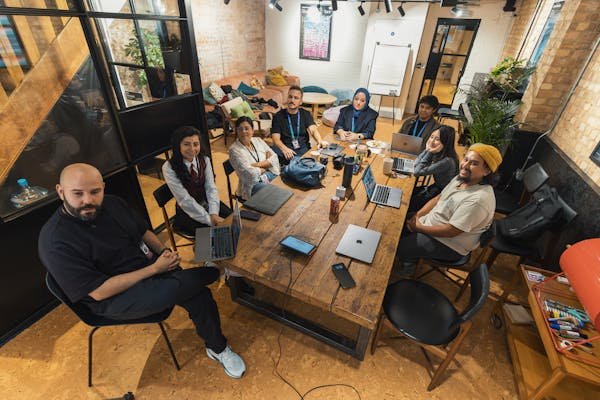The technology mergers and acquisitions (M&A) space has shifted dramatically over the last few years. From historic highs in 2021 to cautious recalibrations in 2023, the numbers tell a fascinating story. In this article, we’ll explore 30 of the most critical statistics shaping the current and future state of tech M&A. Each stat is broken down with clear, practical insights and advice you can act on today—whether you’re an entrepreneur, investor, or M&A advisor.
1. Global tech M&A deal volume reached approximately $580 billion in 2022, down from a record $1.2 trillion in 2021
What this drop tells us
The massive plunge in global tech M&A deal volume from 2021 to 2022 wasn’t just about money. It was about confidence. In 2021, we saw a frenzy—cheap capital, skyrocketing valuations, and growth-at-all-costs strategies. But 2022 brought a sobering reality check.
With inflation rising, interest rates going up, and investor sentiment cooling, many tech companies shifted from expansion to survival. Investors became cautious, boards got tighter on approvals, and everyone started scrutinizing every dollar.
The shift in mindset
In 2021, tech firms bought first and asked questions later. In 2022, the script flipped. Buyers looked deeper into fundamentals, profitability, and long-term value. This created a new rulebook for dealmakers. It’s no longer about who you can buy—it’s about whether that purchase moves the needle in the right way.
What you should do now
If you’re a tech founder, this new environment means two things:
- You need to prove long-term value, not just short-term hype.
- You should build operational efficiency into your story—not just a vision slide.
If you’re a buyer, there’s a silver lining. Fewer competitors in the market means more room to negotiate. Valuations are becoming more reasonable. But you must do your due diligence. Look beyond the surface. A cheaper deal is only good if the core business is sound.
Use this trend as a guidepost: M&A isn’t dead. It’s just growing up.
2. The number of tech M&A deals globally fell by 35% year-over-year in 2023
It’s not just deal value—it’s the volume
Fewer deals were happening overall in 2023. That tells a different story than the drop in value. It shows hesitation. Companies didn’t just spend less—they acted less. This retreat was driven by uncertainty in the market, political instability, and fears of recession.
What does this mean for sellers?
If you’re looking to sell, you now face a more selective buyer pool. You’re not just one of many great startups anymore—you need to rise above the noise. This means tighter documentation, stronger customer retention, and solid financials.
A 35% drop in deal count signals that even great companies might not get attention unless they’re actively working their network and refining their pitch.
What smart buyers are doing
Smart buyers are preparing ahead. They’re watching categories closely and tracking companies even if they’re not ready to buy right now. They’re also setting internal M&A frameworks in motion—like aligning with legal, finance, and integration teams early.
If you’re a potential acquirer, this quieter market is your advantage. The best deals happen when others are standing still.
3. Private equity firms accounted for nearly 38% of total tech M&A deal value in 2023
Why PE firms are leaning into tech
Private equity players have changed the game. Nearly four out of every ten dollars in tech M&A came from PE firms last year. That’s no accident. These firms are flush with dry powder (capital ready to be invested), and tech offers them recurring revenue and scalability that traditional sectors don’t.
What’s different about PE-driven deals
Private equity doesn’t operate like strategic buyers. They’re laser-focused on returns, usually over a 3 to 7-year window. That means they’re targeting companies they can scale, optimize, or flip. They look for underpriced assets or those with clear operational gaps they can fix.
For sellers, this is both an opportunity and a risk. PE firms might offer more cash upfront, but their goals may include aggressive restructuring or consolidation. You need to understand what you’re signing up for.
How to align with PE interest
If you’re a tech founder aiming for a PE exit:
- Demonstrate reliable cash flow and customer stickiness.
- Highlight any systems or processes that can scale quickly.
- Be transparent about risks—PE firms will find them anyway.
Buyers, especially PEs, want a clear plan. Show them how your company becomes more valuable in their hands than in yours.
4. The median deal size in tech M&A fell from $450 million in 2021 to $250 million in 2023
What this says about the market
Deals aren’t just fewer—they’re smaller. This stat reflects a move toward safer bets. Instead of large, bold acquisitions, many firms are focusing on bite-sized, manageable deals. These are easier to integrate, less risky, and often yield quicker wins.
The drop also shows that valuations are coming back to earth. In 2021, companies were often acquired based on aggressive forecasts. Today, it’s about real numbers.
How to leverage this trend
If you’re a smaller tech firm, you’re actually in a stronger position now. Large acquirers are looking for low-risk assets. That gives you an entry point—especially if you’re profitable or own valuable IP.
For buyers, this trend offers breathing room. Smaller deal sizes allow for experimentation and learning without putting the entire balance sheet at risk.
Here’s the mindset shift: Success in M&A isn’t about size. It’s about synergy.
5. Cross-border tech M&A deals made up 28% of total deal volume in 2023
The world’s getting smaller—again
Despite trade tensions and geopolitical complexity, nearly a third of all tech M&A deals in 2023 crossed national borders. This signals that growth-hungry firms are still seeking global reach. It also shows that innovation isn’t confined to Silicon Valley anymore.
What cross-border deals bring to the table
They offer access to new markets, local talent, and diverse customer segments. But they also come with challenges—regulations, cultural gaps, and longer deal cycles.
To succeed, both buyers and sellers need a plan. This includes:
- Understanding local compliance standards
- Mapping integration strategies early
- Engaging local advisors to bridge language or legal differences
The opportunity for mid-market firms
For mid-sized tech companies, international acquirers may offer better terms than domestic ones. If you’re in a niche space with global relevance, think beyond your own borders. Position yourself as a gateway into a specific market or tech stack.
Cross-border isn’t about complexity. It’s about strategy. The firms that plan ahead win the deal—and the value that comes after.
6. North America continued to lead with over 55% of global tech M&A volume in 2023
Why North America still dominates
The United States—and North America more broadly—remains the heartbeat of global tech M&A. With Silicon Valley, deep capital markets, a mature legal system, and a massive base of scalable tech startups, it’s no surprise that more than half of all tech M&A volume in 2023 originated here.
This leadership isn’t just about geography. It’s about ecosystem maturity. U.S. companies typically grow faster, raise more capital, and attract more international acquirers.
What this means for non-U.S. firms
If you’re based outside North America, this stat matters even more. Many foreign startups are aligning their operations or headquarters in the U.S. to attract better M&A prospects. Others are building partnerships or customer bases in North America to make themselves more appealing.
It’s not necessary to be headquartered in the U.S., but you need a North American presence. Even a sales or development office can help bridge that gap.
For U.S.-based acquirers and sellers
For buyers, being in the U.S. gives you leverage—but not a guaranteed edge. You still need to compete with international firms entering the space. For sellers, this environment is competitive, which means standing out matters more than ever.
Consider what makes your company unique. Is it your customer base? Your intellectual property? Your team? Build that into your deal narrative.
7. The Asia-Pacific region saw a 22% increase in domestic tech M&A in the second half of 2023
What’s driving this surge
While global M&A slowed, Asia-Pacific showed resilience. A 22% jump in domestic deals suggests a strengthening ecosystem. Countries like India, China, Japan, and Southeast Asian markets are investing in homegrown innovation and building regional champions.
This growth is driven by several things:
- Rising demand for digital infrastructure
- Government support for local innovation
- A growing pool of private equity and venture capital
Opportunities in regional consolidation
Domestic M&A in Asia is largely focused on market consolidation. Mid-sized firms are merging to expand user bases, pool talent, and prepare for IPOs or larger exits.
If you’re operating in the APAC region, this could be a golden window. Acquirers are actively seeking category leaders in SaaS, fintech, and health tech. Local success stories are being snapped up before global players even notice.
If you’re looking to enter Asia
Don’t just treat APAC as one big market. Each country has its own regulatory and business culture. Tailor your go-to-market strategy. Consider partnerships with local firms. And above all, respect local dynamics. Many deals fail because foreign companies assume a one-size-fits-all approach.
8. Cloud computing and SaaS companies made up more than 40% of all tech M&A targets in 2023
Why cloud and SaaS continue to dominate
Every business is becoming a digital business, and the backbone of that transformation is cloud and SaaS. These companies are attractive because they offer recurring revenue, predictable margins, and massive scalability.
Buyers love these models because they can plug into their own ecosystems quickly and deliver instant value.
What makes a SaaS firm acquisition-worthy
Not all SaaS is created equal. If you’re a SaaS founder thinking about a potential exit, focus on what acquirers really want:
- Low churn rates
- High lifetime customer value (LTV)
- Sticky integrations with customers’ tech stacks
- Strong ARR growth and predictable renewals
Being in the cloud isn’t enough. You need to show operational maturity, pricing discipline, and room for expansion.
For buyers seeking SaaS deals
It’s easy to get swept up by SaaS metrics. But dig deeper. Look at actual usage data, contract structures, and how quickly new features are shipped. Also examine dependency on any one customer or channel.
Acquiring a SaaS company isn’t just buying software—it’s acquiring a machine that must keep running after the deal closes.
9. The average EV/EBITDA multiple in tech M&A transactions decreased from 18x in 2021 to 12x in 2023
What this drop in valuation means
This is one of the clearest signs of how tech M&A has matured post-2021. The drop from 18x to 12x on EV/EBITDA means companies are now being valued on what they actually earn—not what they might earn one day.
Buyers are pushing back on frothy projections and looking for proof.
How to defend or increase your valuation
If you’re a seller, understand that the market has changed. Multiples aren’t what they used to be—and that’s okay. You can still command a premium if:
- Your revenue is profitable or on a clear path to profitability
- You dominate a niche or serve an underserved segment
- You can show stable and expanding margins
Don’t just focus on revenue growth. Show operational control and financial efficiency.
Advice for buyers
This lower multiple means more reasonable entry points. But remember, valuation is only half the story. You need to assess integration costs, team retention, and future performance risks.
Cheap deals are only good if they lead to real outcomes. Look beyond the multiple—look at the engine.
10. Cybersecurity M&A saw a 10% increase in 2023 despite overall market declines
Why cybersecurity is the exception
While most sectors pulled back, cybersecurity kept moving forward. This isn’t surprising. Every tech company—from startups to giants—is under attack. Cyber threats are rising, and enterprises are pouring more money into securing their stacks.
This makes cybersecurity startups incredibly valuable, especially those with:
- AI-powered threat detection
- Cloud-native security tools
- Strong integrations with enterprise IT systems
What buyers are looking for
Buyers want solutions that are proven, scalable, and already integrated into the customer’s ecosystem. Startups with active partnerships with cloud providers or enterprise tools often get premium attention.
If you’re in this space, highlight how your tool reduces breach risk or compliance cost. Quantify it if you can. Show customer retention data.
If you’re thinking of entering cybersecurity
This space is crowded, but not saturated. There’s still plenty of room for innovation in areas like:
- Identity and access management (IAM)
- Zero-trust architecture
- DevSecOps integration
Just remember—cyber buyers want tech that works today, not tomorrow. Focus on execution.
11. AI and machine learning-related M&A deals increased by 28% in 2023
The AI gold rush is real
Even during a cooling M&A market, AI and machine learning were heating up. A 28% rise in M&A deals tied to AI isn’t just a trend—it’s a massive shift. Companies are rushing to acquire AI capabilities, not just for product innovation but also for cost efficiency, customer experience, and automation.
This spike is fueled by the real-world deployment of AI in things like:
- Chatbots and virtual assistants
- Predictive analytics
- Automated decision-making tools
- Custom recommendation engines
Tech giants are snatching up AI startups to stay ahead of the curve. But so are traditional businesses in finance, healthcare, and manufacturing.
For AI startups: what buyers want
To stand out in this red-hot space, AI companies must show more than academic brilliance. Buyers want:
- Clear product-market fit
- Demonstrated use cases and real-world deployment
- Clean, scalable data pipelines
- Minimal regulatory or ethical baggage
If you’re running an AI startup, focus your messaging on outcomes, not algorithms. Show how your tech makes users faster, smarter, or more profitable.
What acquirers should look for
AI tech isn’t just about intellectual property. The value lies in:
- Proprietary data sets
- Engineering talent
- Unique training models
- Real-time deployment systems
Do your technical diligence. Many AI startups exaggerate what their models can actually do in production. Ask for proof, not promises.
12. The median time-to-close a tech M&A deal increased from 87 days in 2021 to 104 days in 2023
Deals are taking longer—for a reason
What used to take under three months now takes nearly four. The median time-to-close rising to 104 days tells us that M&A is getting more complex. This isn’t just about red tape—it’s about caution.
Buyers are digging deeper into diligence. They’re checking for hidden liabilities, verifying product claims, and analyzing risk more closely. In many cases, they’re involving more internal stakeholders before signing off.

Why this matters for both sides
Longer timelines can be frustrating. But if you’re a seller, don’t take it personally. It often reflects better internal processes on the buyer’s side—not a lack of interest.
However, delays can kill momentum. To keep things moving:
- Get your data room organized early
- Pre-negotiate key terms internally
- Have answers ready to common diligence questions
On the buyer side, use this extra time wisely. Develop a robust integration plan and make sure your internal teams are aligned on the post-close strategy.
How to streamline the process
Whether buying or selling, communication is key. Assign a clear deal lead. Set milestone check-ins. Don’t let emails sit unanswered. A well-managed timeline signals professionalism and builds trust.
13. Over 70% of tech M&A deals in 2023 involved targets with under $100 million in annual revenue
Small is the new smart
A large portion of the M&A activity is happening at the lower end of the revenue spectrum. These sub-$100M businesses are agile, niche-focused, and often have strong teams or IP.
This shift means buyers are hunting for hidden gems. They’re less interested in bloated unicorns and more focused on scrappy innovators that can deliver value quickly.
What this means for startups
If your revenue is under $100 million, you’re in the sweet spot. But you need to be deal-ready. That means:
- Having clean, auditable financials
- Documenting your code base and IP ownership
- Preparing customer and revenue metrics that show momentum
Buyers see smaller companies as less risky in today’s uncertain environment. Lower purchase prices mean fewer integration headaches and quicker ROI.
Why acquirers are focusing here
Acquiring smaller firms allows for more flexibility. Buyers can:
- Plug startups into their existing platform without massive disruption
- Test new markets or tech without going all-in
- Retain key talent more easily
So even if your company feels “too small to matter,” don’t discount your value. Size isn’t the most important metric—fit is.
14. The SPAC-related tech deals dropped by over 80% in volume in 2023 compared to their peak in 2021
The SPAC bubble has burst
Remember SPACs? In 2021, they were everywhere. But now? Not so much. The collapse in SPAC-driven tech M&A—an 80% drop—is one of the clearest signs that easy money is gone.
SPACs (Special Purpose Acquisition Companies) were used as a fast-track to take companies public. But many of those deals were poorly vetted. As scrutiny increased and post-SPAC performance lagged, investor appetite dried up.
What this means for M&A today
The decline in SPAC deals doesn’t mean IPOs or exits are dead. It just means they’ve returned to more traditional paths—like strategic M&A or direct listings.
If you’re a startup eyeing a liquidity event, forget shortcuts. Focus on fundamentals. The market now rewards sustainability, not hype.
Advice for buyers and founders
For founders who were once considering a SPAC, redirect that energy. Build a long-term path to profitability. Engage with strategic acquirers who understand your business—not just those who want a quick flip.
For buyers, be cautious of SPAC-born companies. Some may be undervalued now and present good opportunities—but do your homework. Look for operational soundness, not just brand visibility.
15. Strategic acquirers dominated the tech M&A scene, making up 62% of total deals in 2023
Why strategics are leading the charge
Strategic acquirers—companies buying other companies to grow their core business—now account for nearly two-thirds of all tech M&A activity. These are not short-term plays. These deals are about long-term value.
Unlike private equity firms, strategic buyers aren’t looking to flip the business. They’re looking to fold it in, scale it up, and generate synergy.
What this means for sellers
If you’re aiming to sell, understand what motivates strategic acquirers:
- They want technology that fills a product gap
- They’re looking for customer bases that complement their own
- They seek teams that can execute within a larger org
To get their attention, tailor your messaging. Don’t just pitch your business—pitch how your business helps theirs.
Tips for strategic buyers
If you’re a strategic acquirer, competition is heating up. You’ll often be up against other strategics chasing the same targets. To stand out, offer more than just a good price. Offer clarity.
Founders care about culture. About impact. About legacy. Position your company as the best long-term home for their vision. That’s how you win deals in this environment.
16. Software firms continued to dominate tech M&A, accounting for over 50% of transactions
Why software still wins
Software companies remain the top targets in M&A, taking up more than half of all deal activity. This isn’t just a tech fad—it’s because software has become central to how the modern world runs. From logistics and HR to marketing and security, software powers every major business process today.
Another reason? Margins. Software—especially subscription-based software—offers extremely high gross margins and recurring revenue. That’s gold to buyers.
What makes software so acquisition-friendly
There are several qualities that make software companies ideal acquisition candidates:
- Scalable business models with low incremental cost
- High customer retention through subscription billing
- Global reach with little physical infrastructure
- The ability to integrate into larger platforms with ease
Buyers also love the data that software companies generate. That customer usage data, when paired with the right analytics, is often as valuable as the product itself.

How to position your software firm for acquisition
If you run a software company, these are a few levers that can increase your attractiveness:
- Build a strong API and ecosystem integration
- Keep your churn rate low
- Document your tech stack clearly
- Build modular, updateable code to ease integration
And finally, tell a simple story. Buyers want to know what problem you solve, for whom, and why you do it better than others. That story matters as much as the code.
17. Deal abandonment rate for tech M&A increased to 15% in 2023, up from 9% in 2021
More deals are falling apart
Deals falling through before they close is becoming more common—rising from 9% to 15% in just two years. This isn’t just a stat. It’s a warning. It tells us that the environment is more volatile and that trust and preparation matter more than ever.
There are many reasons why deals fall apart:
- Shaky financials uncovered during due diligence
- Misalignment on valuation or cultural fit
- Regulatory red flags or legal concerns
- Changes in market conditions mid-process
How to avoid deal collapse as a seller
If you’re a seller, it’s your job to keep the deal alive once interest is shown. That means:
- Being transparent from day one
- Anticipating red flags and addressing them early
- Having all your documents in order—financials, legal, product, HR
Be proactive with communication. Don’t let silence cause doubt. And avoid surprises. Surprises kill deals.
Tips for buyers
For buyers, don’t rush. Take your time to understand the seller’s motivations. Dig deep into the business model and team culture. More often than not, it’s not the numbers that tank the deal—it’s misalignment on how people will work together post-close.
And if you see red flags, don’t ignore them. You’re better off walking away early than dealing with a broken integration later.
18. European tech M&A accounted for 17% of global deal value in 2023
Europe is a steady force in global M&A
While North America leads in volume, Europe remains a steady contributor—accounting for 17% of global tech M&A value. The region may not move as fast as Silicon Valley, but it offers something just as important: stability.
Europe has deep talent pools, mature markets, and strict but clear regulatory frameworks. That makes it especially attractive for acquirers looking for risk-adjusted growth.
Key sectors driving European tech deals
- Fintech (especially in the UK and Germany)
- Healthtech (led by Scandinavian countries)
- Green and climate tech (emerging across the EU)
- AI and data science hubs (notably in France and the Netherlands)
If you’re a European startup in these fields, your exit window is very much alive.
How to get noticed in the European M&A market
If you’re a founder in Europe looking to attract acquirers, make sure your company:
- Has clean corporate governance and clear IP ownership
- Can operate across borders and currencies
- Maintains strong data compliance (especially with GDPR)
And consider dual-language documentation. Many acquirers come from outside the region, and clarity helps accelerate deals.
19. The median revenue multiple for SaaS deals fell from 12x in 2021 to 6.5x in 2023
Valuations are coming back to earth
SaaS was once the darling of tech M&A—so much so that revenue multiples ballooned to 12x during the 2021 peak. But by 2023, the bubble deflated, bringing median revenue multiples down to a more sober 6.5x.
This reset was necessary. Many companies were being valued on growth alone, without a sustainable business model behind it. Today, the focus is back on profitability and retention.
What this means for sellers
If you’re a SaaS founder looking to sell, this might feel disappointing. But it’s actually good news. Why? Because realistic valuations attract serious buyers. It creates a healthier ecosystem where good businesses stand out—not just hyped ones.
To hold your valuation or justify a premium multiple, focus on:
- High gross margins (70% or higher)
- Low churn and high net retention
- Clear cost control and efficient CAC (Customer Acquisition Cost)
Advice for buyers
Lower revenue multiples create excellent buying opportunities. But don’t just hunt for cheap deals. Hunt for scalable ones.
Look for SaaS companies with strong developer foundations, efficient onboarding, and the ability to upsell or cross-sell. These levers drive ROI post-acquisition—even more than the purchase price.
20. VC-backed tech startups made up 34% of total tech M&A targets in 2023
Venture-backed startups are still a big part of the pie
One in three M&A targets in 2023 had venture capital backing. That’s a big number, and it shows how deeply VC is woven into the tech innovation pipeline. Even with funding slowing down, VCs are still helping startups reach exit velocity.
Startups with VC money are often more visible, faster-growing, and already operating in high-demand markets. That makes them attractive targets, especially for strategic buyers who want to plug innovation into their larger platforms.
What founders need to know
If you’re running a VC-backed startup, your cap table matters. Acquirers will look at:
- Who owns what
- Preferred vs common share structures
- Liquidation preferences
- Voting rights and board control
Having too many layers of investors or unclear ownership can stall—or sink—a deal. Clean it up early.

Also, remember that your investors might have different motivations than you. Some want quick returns, others want long-term value. Make sure you’re aligned before you start M&A discussions.
For acquirers targeting VC-backed firms
If you’re a buyer, VC-backed companies are great—but expect some complexity. Investors may ask for board seats, retention packages, or earn-outs. Go in prepared and understand the full decision-making landscape.
Also, remember that VC-backed companies are often built for speed, not sustainability. Make sure their operations are scalable and not just duct-taped together for demo day.
21. Antitrust scrutiny delayed 11% of large-cap tech M&A deals in 2023
Regulatory heat is turning up
As big tech firms continue to grow larger and acquire more, governments around the world are stepping in. In 2023, 11% of large-cap tech deals faced delays due to antitrust reviews.
These aren’t small hiccups—they’re serious slowdowns. Some deals were stuck for months. Others had to be restructured. A few were abandoned entirely.
This is especially common in sectors where a handful of players dominate, like:
- Cloud infrastructure
- Online advertising
- App marketplaces
- Data analytics platforms
What founders and sellers should prepare for
If you’re negotiating with a large buyer, be aware that even the best deal can get held up. While this mostly affects massive deals, it still matters for startups because delays can cause internal disruption, missed milestones, and retention risk.
Have contingency plans. Stay focused on core growth while the deal works its way through regulatory processes.
Also, ensure your documentation is solid. Regulators will look into contracts, competitive practices, and pricing models. Be clean, be fair, and be transparent.
What buyers need to consider
If you’re a large-cap acquirer, assume regulators are watching. Structure deals in a way that limits market concentration arguments. Also consider preparing proactive disclosure documents or engaging legal teams with experience in M&A antitrust review.
And remember: regulators aren’t saying “no” to deals. They’re saying “prove it’s good for the market.”
22. Tech M&A deal volume in healthcare tech increased by 19% year-over-year in 2023
Healthtech is having its moment
While many areas of tech saw a dip, healthcare tech bucked the trend—posting a 19% increase in M&A deal volume in 2023. The reason is simple: healthcare is going digital at warp speed, and buyers want in.
The pandemic accelerated this shift, but it’s not just about telemedicine anymore. Acquirers are chasing innovation in:
- Remote patient monitoring
- Health data platforms and analytics
- AI-driven diagnostics
- Mental health and wellness apps
- Insurance tech (insurtech)
Why healthtech is so attractive
The healthcare industry is enormous, yet inefficient. Buyers see healthtech as a way to plug gaps, cut costs, and open new revenue streams.
There’s also a heavy interest in companies that help with regulatory compliance (like HIPAA in the U.S.) or those improving patient outcomes using data.
If you’re a founder in this space, your exit window is wide open.
How to make your healthtech firm M&A-ready
Focus on these three areas:
- Data privacy: Make sure your systems are fully compliant with data protection laws.
- Clinical validation: Show real-world impact or partnerships with health providers.
- Scalability: Demonstrate that your tech can handle growth—especially in enterprise settings.
If you’re on the buy-side, understand that integration in healthcare takes time. Be prepared for long sales cycles and complex onboarding. But if done right, the upside is huge.
23. Digital transformation was a stated rationale in over 45% of tech M&A press releases in 2023
The transformation narrative is driving deals
When companies announced their acquisitions in 2023, nearly half pointed to “digital transformation” as the main reason. This isn’t just corporate speak. It’s a sign that businesses of all types—not just tech firms—are using M&A to modernize.
Digital transformation is broad. It includes:
- Moving operations to the cloud
- Automating manual processes
- Adopting AI for decision-making
- Enhancing customer experience
M&A gives these companies a shortcut. Instead of building tech from scratch, they buy ready-made tools and teams.
What this means for tech sellers
If your product helps companies modernize, digitize, or automate—you’re exactly what buyers want.
But it’s not enough to say your software “drives transformation.” You need to:
- Show the before-and-after impact for customers
- Provide case studies with measurable ROI
- Highlight ease of integration
The more tangible the value, the faster you’ll get buyer interest.

What acquirers should be careful about
Buying for transformation works—if you have a plan. Before you acquire, ask:
- Will this integrate with our existing stack?
- Do we have the internal capability to manage this shift?
- Are the team and tech future-proof?
Buying without a change plan leads to shelfware—tools that get acquired but never used. Don’t let that happen.
24. Fintech M&A saw a sharp drop, with deal volume decreasing by 32% in 2023
Fintech hits the brakes
After a huge run from 2019 to 2021, fintech M&A hit a wall in 2023. Deal volume fell by 32%, making it one of the hardest-hit tech verticals.
Why the slowdown?
- Rising interest rates hurt lending startups
- Regulatory uncertainty increased for neobanks and crypto firms
- Valuations ballooned in 2021, leaving many overvalued in 2023
Still, this isn’t a sign of fintech failure. It’s a reset. The weak are being weeded out. The strong are still building.
For fintech founders
If you’re still growing despite market headwinds, you’re more attractive than ever. But expect tougher questions from buyers. They’ll ask:
- How are you handling compliance and licensing?
- What’s your exposure to market volatility?
- Is your revenue real—or incentive-driven?
You’ll need to back your numbers with clear user retention data, low fraud risk, and strong infrastructure.
For fintech buyers
This is a great time to buy—if you’re disciplined. Look for companies with:
- Embedded finance capabilities
- Real-time payment platforms
- RegTech and KYC solutions
And be prepared to deal with regulatory bodies. A strong legal framework is essential when acquiring in fintech.
25. The top 10 tech acquirers were responsible for over $110 billion in combined deal value in 2023
Big players are still spending
Despite market caution, the biggest tech companies stayed active. Just ten of them accounted for more than $110 billion in deal value in 2023. This shows that the M&A game is still very much alive at the top.
These firms include well-known giants across:
- Cloud infrastructure
- Social platforms
- Semiconductors
- Enterprise software
They’re buying to fill product gaps, grow faster, and eliminate future competition. But they’re doing it more carefully now—with more focus on fit and strategic alignment.
What this means for sellers
Getting acquired by a top player is still the dream—but also a challenge. These buyers are thorough. They have long processes. They involve dozens of stakeholders.
To even get on their radar, you need to:
- Be the best at what you do in a specific category
- Prove your product is enterprise-grade
- Show your culture and team are integration-ready
Being visible helps, too. Attend conferences. Build relationships with corporate development teams. Get your name out there.
What smaller acquirers can learn
Smaller firms can’t outspend the giants—but they can outmaneuver them. They can:
- Move faster
- Offer more flexible deal structures
- Provide founders with more leadership autonomy post-deal
And many startups prefer that. So even if you’re not spending $10 billion a year, you can still win good deals—if you understand what founders care about.
26. Tech carve-out deals increased by 12%, driven by portfolio optimization strategies
What are carve-out deals—and why are they rising?
Carve-outs happen when a larger company sells off a part of its business, usually a non-core unit. In 2023, these deals rose by 12% in tech, showing a new strategy in motion: portfolio optimization.
With slower growth and higher capital costs, big firms are cutting loose what doesn’t align with their core mission. They’re selling product lines, business units, or legacy tech stacks to focus on what really moves their bottom line.
Why this is important for buyers
Carve-outs can be goldmines. The unit being sold might have strong customers, great talent, and valuable IP—just not a strategic fit for the parent company. For buyers, this means:
- Lower competition for deals
- Clear upside if operated independently
- Opportunities for rapid turnaround
However, carve-outs often lack standalone infrastructure. You may need to rebuild systems, HR, or finance operations from scratch.
What founders and mid-sized firms should watch
Carve-outs can create sudden competitors. A business that was buried inside a large firm can become a lean, focused rival once sold.

Or, they can be acquisition targets themselves. If you’re eyeing growth, consider buying carved-out assets that complement your core product.
The key takeaway? When companies trim the fat, new opportunities emerge—for competitors, investors, and nimble acquirers.
27. AI-related acquisitions reached over $40 billion in announced deal value in 2023
AI isn’t just hype—it’s money in motion
AI isn’t a buzzword anymore. It’s a budget. In 2023 alone, announced AI-focused acquisitions crossed $40 billion in deal value.
Companies aren’t just dipping their toes into artificial intelligence—they’re jumping in, often by buying established players or promising startups.
Why? Because building AI in-house is hard. It requires data, compute power, and specialized talent. Acquiring a proven AI solution saves time and gets results faster.
What makes an AI company acquisition-ready
If you’re building in this space, here’s what buyers look for:
- Proprietary data sets or models
- Use cases with measurable business value
- Strong engineering teams with real-world deployment experience
- Integration potential with legacy systems
Avoid overly academic positioning. Instead, show how your AI improves business outcomes—revenue lift, cost savings, churn reduction.
Advice for acquirers
Before buying, dig into the technical foundation. Ask:
- Is the AI truly proprietary or built on open-source models?
- Are the results reproducible at scale?
- Can it integrate cleanly with our existing platforms?
And always do a talent audit. In AI, people are as valuable as the product.
28. Cloud infrastructure targets saw a deal value increase of 15% year-over-year in 2023
The cloud is still growing—and attracting buyers
While many areas of tech slowed in 2023, cloud infrastructure stood tall. Deal value here grew by 15%, driven by demand for scalable, secure, and cost-effective backend solutions.
Buyers are looking for infrastructure that powers:
- Hybrid cloud deployment
- Edge computing
- Developer platforms and DevOps tools
- Automation for provisioning, scaling, and monitoring
These aren’t flashy consumer apps—they’re behind-the-scenes engines that keep digital businesses running.
What makes a cloud company attractive
Founders, if you’re in this space, you’re in luck. But competition is fierce, so focus on:
- Performance: Low latency, high availability, strong SLAs
- Security: Enterprise-grade encryption and compliance
- Developer experience: Great docs, simple APIs, and responsive support
- Ecosystem: Plug-and-play integrations with major platforms
Buyers want reliability and extensibility—not just a cool dashboard.
What buyers need to examine
Cloud businesses often come with technical debt. Review architecture closely. Evaluate migration timelines and infrastructure costs. And ensure you understand customer dependencies—especially if large enterprise accounts are involved.
Done right, these acquisitions create long-term value. But they demand technical diligence.
29. Over 90% of tech M&A deals included earn-outs or contingent payment structures in 2023
Deal structures are getting more creative—and cautious
With market uncertainty rising, buyers are protecting themselves. In 2023, over 90% of tech M&A deals included earn-outs or other contingent payments—where part of the purchase price is tied to future performance.
This means fewer all-cash upfront deals. Instead, founders and shareholders must hit milestones—like revenue, EBITDA, or customer growth—to unlock the rest.
What sellers need to know
If you’re considering a deal, understand the terms inside out:
- What are the exact performance metrics?
- How are they measured?
- Who controls the business post-close?
Negotiate from a position of clarity, not hope. You don’t want to lose control and miss an earn-out because of a change in how performance is tracked.
Also, push for fairness. If targets are aggressive, ask for higher upside. If they’re conservative, negotiate for more guaranteed payment.
What buyers should consider
Earn-outs are useful—but only if they’re structured clearly. Don’t let vague definitions cause legal battles a year from now.
Also, remember that earn-outs can affect retention. Founders who feel tricked may walk. Design terms that incentivize—not punish—them.
Ultimately, a fair deal is one where both sides are aligned on what success looks like and how it’s shared.
30. Digital media and adtech M&A deals dropped by 25% in volume from 2022 to 2023
The shine is fading—for now
After years of heavy M&A in digital media and adtech, 2023 saw a 25% drop in deal volume. Rising customer acquisition costs, data privacy crackdowns, and cookie deprecation all played a role in this pullback.
Buyers became wary of overpaying for platforms reliant on third-party data or fragile ad monetization models.
Also, many adtech firms scaled fast during the pandemic—but struggled with post-iOS privacy changes and rising CPMs.

What this means for sellers
If you’re in media or adtech, the bar is higher now. To attract buyers, you need:
- First-party data strategies
- Predictable revenue models
- Audience loyalty and direct user engagement
- Diversified income streams (not just ads)
Showing you can survive in a post-cookie world is essential.
For buyers
There’s still value in this space—especially in:
- Contextual targeting tools
- Influencer marketing platforms
- Video streaming infrastructure
- Brand safety and analytics software
But diligence is key. Review traffic quality, attribution models, and advertiser churn. Avoid shiny front-ends with no back-end sustainability.
Media isn’t dead. It’s just evolving—and deals will follow those who evolve with it.
Conclusion
The tech M&A landscape is maturing fast. Gone are the days of blind optimism and inflated valuations. We’re in a new era—one that rewards clarity, execution, and real impact.
If you’re a founder, think like a buyer. Build for resilience, not hype. If you’re a buyer, look past surface-level metrics and focus on integration, culture, and long-term value.





















